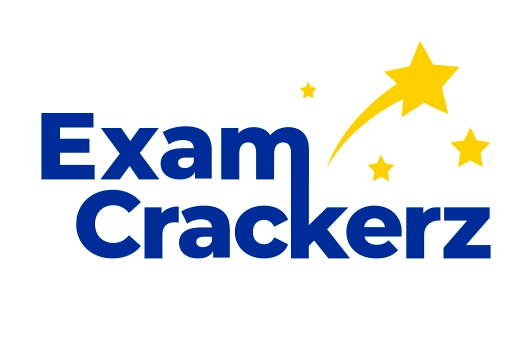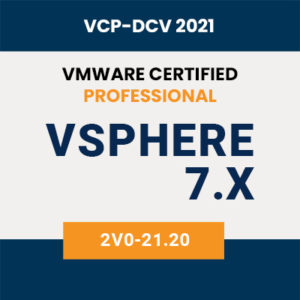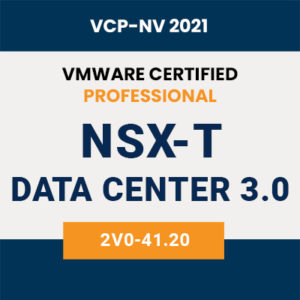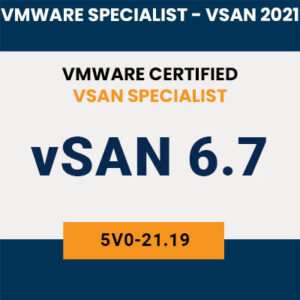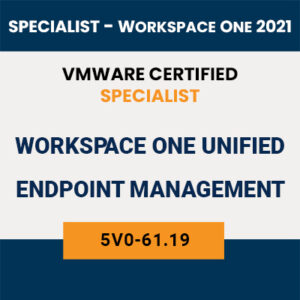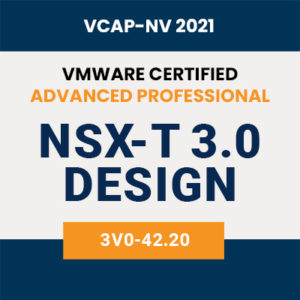Description
VCAP-NV 2021 -VMware Certified Advanced Professional NSX-T 3.0 Design (3V0-42.20) Exam Details
The Advanced Design VMware NSX-T Data Center 3.0 exam, 3V0-42.20 which leads to VMware Certified Advanced Professional – Network Virtualization Design 2021, VCAP-NV 2021 certification is a 57-item exam, with a passing score of 300 using a scaled method. Candidates are given an appointment time of 130 minutes, which includes adequate time to complete the exam for non-native English speakers and 105 minutes for native English speakers to complete the exam.
Exam Delivery
This is a proctored exam delivered through Pearson VUE. For more information, visit the Pearson VUE website.
Certification Information
For details and a complete list of requirements and recommendations for attainment, please reference the VMware Education Services – Certification website.
Minimally Qualified Candidate
The minimally qualified candidate should have 1 year of experience designing NSX-T Data Center solutions and 2 or more years designing physical and virtual data centers/networks. Candidates will be adept at documenting requirements, risks, constraints, and assumptions. The successful candidate will likely hold additional industry-recognized IT certifications or accreditation. The MQC should have all the knowledge contained in the exam sections listed below.
Exam Sections
VMware VCAP-NV 2021 (3V0-42.20) exam blueprint sections are now standardized to the seven sections below, some of which may NOT be included in the final exam blueprint depending on the exam objectives.
Section 1 – Architecture and Technologies
Section 2 – Products and Solutions
Section 3 – Planning and Designing
Section 4 – Installing, Configuring, and Setup
Section 5 – Performance-tuning, Optimization, and Upgrades
Section 6 – Troubleshooting and Repairing
Section 7 – Administrative and Operational Tasks
If a section is missing from the list below, please note it is because the exam has no testable objectives for that section. The objective numbering may be referenced in your score report at the end of your testing event for further preparation should a retake of the exam be necessary.
Sections Included in the Exam VCAP-NV 2021 (3V0-42.20)
Section 1 – Architectures and Technologies – There are no testable objectives for this section
Section 2 – VMware Products and Solutions- There are no testable objectives for this section
Section 3- Planning and Designing
Objective 3.1 – Create a Conceptual Design for the NSX-T Data Center
Objective 3.1.1 – Gather Customer Requirements
Objective 3.1.2 – Analyze and Differentiate Requirements, Risks, Constraints, Assumptions, and Use Cases
Based on the Current Customer Environment.
Objective 3.2 – Create a Logical Design for NSX-T Data Center
Objective 3.2.1 – Map Business Requirements to the Logical Design
Objective 3.2.2 – Map NSX-T Data Center Solution Dependencies
Objective 3.2.3 – Analyze Availability Requirements
Objective 3.2.4 – Analyze Manageability Requirements
Objective 3.2.5 – Analyze Performance Requirements
Objective 3.2.6 – Analyze Recoverability Requirements
Objective 3.2.7 – Analyze Security Requirements
Objective 3.2.8 – Analyze Scalability Requirements
Objective 3.3 – Create a Physical Design for NSX-T Data Center
Objective 3.3.1 – Create a Physical Design for NSX-T Data Center Compute
Objective 3.3.2 – Create a Physical Design for NSX-T Data Center Storage
Objective 3.3.3 – Create a Physical Design for NSX-T Data Center Networking
Section 4 – Installing, Configuring, and Setup- There are no testable objectives for this section
Section 5 – Performance-tuning, Optimization, Upgrades – There are no testable objectives for this section
Section 6 – Troubleshooting and Repairing – There are no testable objectives for this section
Section 7 – Administrative and Operational Tasks – There are no testable objectives for this section
VCAP-NV 2021 Exam Duration: 105 minutes
VCAP-NV 2021 Number of Questions: 57
VCAP-NV 2021 Passing Score: 300
Format: Single and Multiple Choice, Proctored
